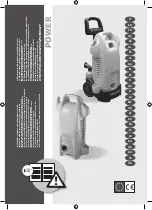
22
Run water for a few seconds through hose into a laundry
tub, drainpipe, or bucket to avoid clogs. Water should run
until clear.
9.
Clear water line
8.
Connect inlet hose to water faucet
Place hose into standpipe (shown in picture) or over side of
laundry tub.
IMPORTANT:
Only 4
1
⁄
2
" (114 mm) of drain hose should be
inside standpipe; do not force excess hose into standpipe or
lay on bottom of laundry tub. Drain hose form must be used.
7.
Place drain hose in standpipe
Connect Inlet Hose
Washer must be connected to the cold water faucet with a new
inlet hose with a flat washer. Do not use the old hose.
NOTE:
Hose must be attached and have water flowing to
inlet valve.
Attach hose to cold water faucet. Screw on coupling by hand
until it is seated on washer. Use pliers to tighten couplings
an additional two-thirds turn.
IMPORTANT:
Do not overtighten or use tape or sealants on
valve when attaching to faucet or washer. Damage can result.
10.
Connect inlet hose to washer
Attach water hose to water inlet valve. Screw coupling
by hand until it is snug. Use pliers to tighten coupling an
additional two-thirds turn.
IMPORTANT:
To reduce risk of hose failure, replace the hose
every 5 years. Record hose installation or replacement dates
for future reference.
n
Periodically inspect and replace hose if bulges, kinks, cuts,
wear, or leaks are found.
Slowly turn on water faucet to check for leaks. A small amount
of water may enter washer. It will drain later.
11.
Check for leaks
Cold Water















































